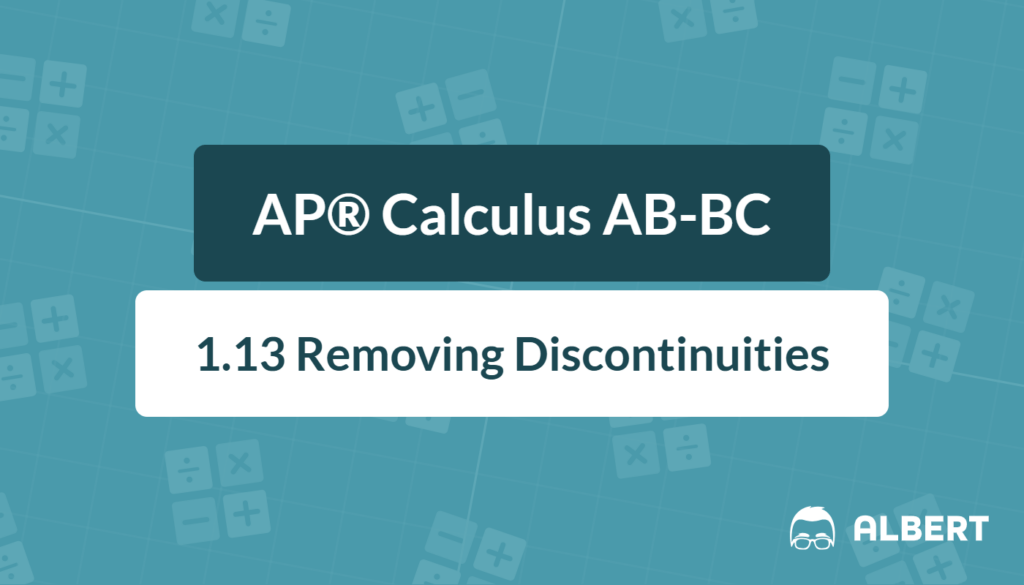Ever stared at a smooth curve that suddenly has a tiny gap? That “missing pixel” is a key idea on the AP® Calculus AB–BC exams (LIM-2.C.1 & LIM-2.C.2). Understanding it can earn easy points on limit questions. This post explains what a removable discontinuity is, how to see it on a graph, and how to “patch the hole” so the function becomes continuous.
What We Review
What Is a Removable Discontinuity?
A removable discontinuity is a point where the graph should have a value, yet the function is either undefined or defined at a different height. In plain words, the curve wants to be connected, but something is missing. AP® synonyms include “hole” and “point discontinuity.”
Example #1
Identify and label the removable discontinuity off(x)=\dfrac{x^{2}-1}{x-1}
Solution
- Factor numerator: x^{2}-1=(x-1)(x+1).
- Simplify: f(x)=\dfrac{(x-1)(x+1)}{x-1}=x+1,\quad x\neq1.
- The simplified rule is x+1, yet x=1 is excluded. Therefore, the limit as x\to1 equals \lim_{x\to1}(x+1)=2.
- The graph displays a hole at (1,2).
Therefore, x=1 is a removable discontinuity.
Why Do Discontinuities Appear?
Algebra often creates gaps when a factor cancels a zero denominator. The original fraction is undefined, yet after canceling, the new expression behaves nicely. Graphically, the removable discontinuity graph shows a single open circle, not a jump or vertical asymptote.
Example #2
Show that g(x)=\dfrac{x^{2}-9}{x-3} has a removable discontinuity and find its location.
Solution
- Factor top: x^{2}-9=(x-3)(x+3).
- Simplify: g(x)=x+3,\quad x\neq3.
- The limit exists: \lim_{x\to3}(x+3)=6.
- Because g(3) is undefined, a hole occurs at (3,6).
How to Spot a Removable Discontinuity on a Graph
On a coordinate plane, a removable discontinuity appears as an open circle sitting on an otherwise smooth curve. However, a jump discontinuity has two distinct heights, and an infinite discontinuity shoots to ±∞.
Use this checklist on test day:
- Are the left-hand and right-hand limits equal?
- Is the function value either missing or different?
- Does the graph stay finite near the point?
Example #3
A graph shows an open circle at (–2, 3) but otherwise follows the line y = –x + 1. Determine an equation that matches the graph.
Solution
- Write the rule of the line: y=-x+1.
- Introduce a factor causing the hole at x = –2: multiply by \dfrac{x+2}{x+2}.
- Equation: h(x)=\dfrac{(-x+1)(x+2)}{x+2}.
- The hole occurs where x+2=0\Rightarrow x=-2. The limit is h(-2)= -(-2)+1=3, matching the graph.
Removing the Discontinuity Algebraically
The AP® phrase “1.13 removing discontinuities” describes the simple fix:
- Factor numerator and denominator.
- Cancel the common factor.
- Redefine the function value at the troublesome x-value.
Example #4
Remove the discontinuity from p(x)=\dfrac{x^{2}-4x+4}{x-2} and write a new function.
Solution
- Factor: x^{2}-4x+4=(x-2)^{2}.
- Simplify: p(x)=x-2,\quad x\neq2.
- Limit: \lim_{x\to2}(x-2)=0.
- Define the patched function
Now P(x) is continuous everywhere, satisfying LIM-2.C.1.
Piecewise-Defined Functions and Boundary Points
Continuity at a boundary requires the left-hand and right-hand limits to match the chosen function value (LIM-2.C.2). Therefore, limits are tested from both sides.
Example #5
Find k so that
f(x)=\begin{cases}kx+1, & x<4,\\[6pt]x^{2}-7, & x\ge4\end{cases}is continuous at x=4.
Solution
- Left-hand limit: \lim_{x\to4^{-}}(kx+1)=4k+1.
- Right-hand limit & value: \lim_{x\to4^{+}}(x^{2}-7)=4^{2}-7=9.
- Set equal: 4k+1=9\Rightarrow4k=8\Rightarrow k=2.
Therefore, with k=2, the piecewise function is continuous. This aligns with “graphing a piecewise defined function” techniques.
Quick Reference Chart
| Term | Definition |
| Limit | Expected y-value as x approaches c |
| Removable Discontinuity | A hole where the limit exists but f(c) is wrong or missing |
| Continuous Function | No breaks; limit equals function value at every point |
| Boundary Point | x-value where pieces of a piecewise rule meet |
| Piecewise Function | Function defined by different rules on different intervals |
AP® Exam Tips and Common Pitfalls
- Always show factoring before canceling; scorers look for that step.
- Never divide by zero when simplifying.
- After canceling, explicitly state the value used to patch the hole.
- Clearly write one-sided limits when verifying continuity at a boundary.
- Label holes on sketches; many free-response rubrics allot a point for this detail.
Conclusion
Removable discontinuities are friendly hurdles: the limit exists, and a simple redefinition repairs the graph. Mastering this skill boosts confidence with limits, piecewise functions, and graph interpretation. Keep practicing “What is a removable discontinuity?” on both paper and calculator views. That small hole can turn into an easy point on the AP® test—and a smoother path through calculus.
Sharpen Your Skills for AP® Calculus AB-BC
Are you preparing for the AP® Calculus exam? We’ve got you covered! Try our review articles designed to help you confidently tackle real-world math problems. You’ll find everything you need to succeed, from quick tips to detailed strategies. Start exploring now!
Need help preparing for your AP® Calculus AB-BC exam?
Albert has hundreds of AP® Calculus AB-BC practice questions, free responses, and an AP® Calculus AB-BC practice test to try out.








